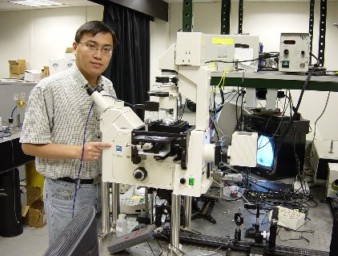Postdoctoral Research Associate

Outer hair cells (OHCs) are required for normal mammalian hearing as they are a source of the mechanical energy that enhances cochlear filtering. OHCs exhibit the unique property of actively altering their cell length in response to changes in the transmembrane potential, which is termed electromotility . I am using optical tweezers to study OHC membrane biomechanical properties through tether-pulling technique. Trapped with high focused laser beam, a bead is first attached to OHC lateral wall plasma membrane, and then moved away at a constant rate. In the process, a tether of membrane material linking the bead and cell is stretched. Bead displacements during tether elongation are monitored by a quadrant photodetector to obtain time-resolved measurements of the tethering force, which is believed to be associated with cell membrane biomechanics. To further study the OHC electromechanical and mechanoelectrical properties, I have integrated patch-clamp setup into the optical-tweezers system. With the changes of transmembrane potential, OHCs show tethering force changes, and so do prestin-transfected human embryonic kidney (HEK) cells and wildtype HEK cells. Also, membrane capacitance changes are recorded during the tether-pulling process. The combination of optical tweezers and patch-clamp techniques may help us to understand the mechanism underlying electromotility.
Office Phone: (713)-348-3018
Fax: (713)-348-5877
e-mail: fengqian at rice.edu


